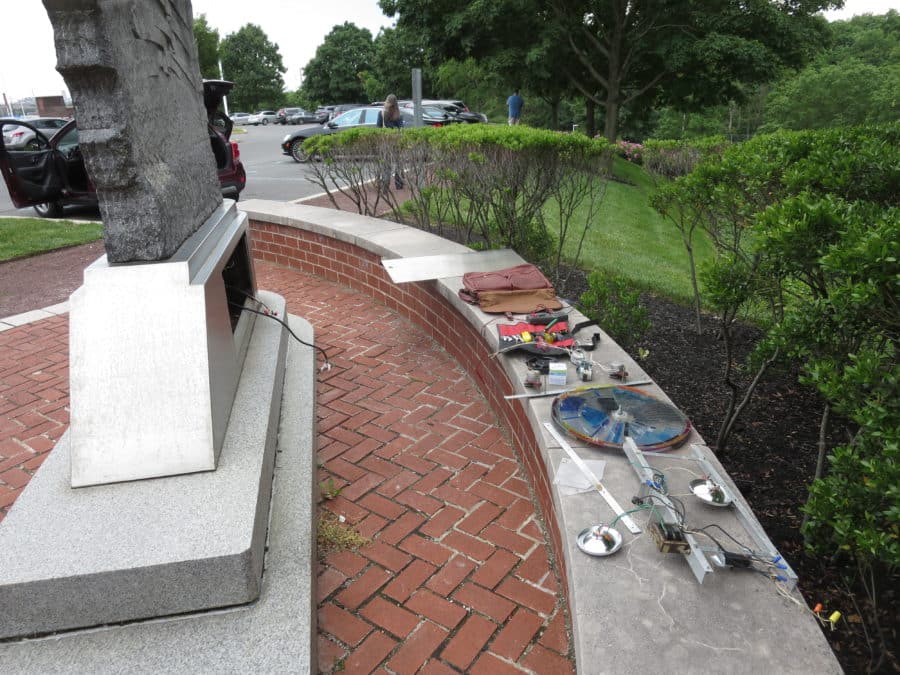Electronic Media and Optical Artifact Conservation, Public Art Conservation:
 Don’t let the simple but sinuous lines of Clyde Lynds’ Sentinel fool you. This concrete eagle accompanied by a stainless steel and stepped granite base houses a complex motorized kinetic illumination system. The piece is characteristic of his Public Artworks, which are made of traditional materials such as stone, metal, or glass and accompanied by a lighting component. These materials then marry together creating an architectural, and arguably regal, feel to his work.
Don’t let the simple but sinuous lines of Clyde Lynds’ Sentinel fool you. This concrete eagle accompanied by a stainless steel and stepped granite base houses a complex motorized kinetic illumination system. The piece is characteristic of his Public Artworks, which are made of traditional materials such as stone, metal, or glass and accompanied by a lighting component. These materials then marry together creating an architectural, and arguably regal, feel to his work.
Sentinel is located outside of the Philadelphia Veterans Administration building in Philadelphia, PA, and when it was first installed in 1998, it was lit with a variety of ever-changing colors. About a year ago, the sculpture reportedly went dark.
 Conservator and Company President, Robert (Bob) Lodge was tasked to perform a full condition assessment of the sculpture by artist Clyde Lynds. Conservator Bob Lodge reviewed previous records as well as made notes of his observations about the current condition. The surface of the eagle had biological growth and/or city soot which darkened its appearance, the stainless steel had minor corrosion, and the granite base blocks had failed or missing caulk. These condition issues are common to any artwork exposed to the elements. Treatment of the exterior is a more typical scenario. As with other stone or concrete treatments the black discoloration is removed with a conservation grade stone cleaner and pressure washer, an acidic solution is applied to clean and passivate the stainless steel, and the caulk on the granite base is removed and replaced. The interior of the sculpture, however, is another matter as it is comprised of a series of complex components including motors, electrical wiring, fiber optics, and color wheels.
Conservator and Company President, Robert (Bob) Lodge was tasked to perform a full condition assessment of the sculpture by artist Clyde Lynds. Conservator Bob Lodge reviewed previous records as well as made notes of his observations about the current condition. The surface of the eagle had biological growth and/or city soot which darkened its appearance, the stainless steel had minor corrosion, and the granite base blocks had failed or missing caulk. These condition issues are common to any artwork exposed to the elements. Treatment of the exterior is a more typical scenario. As with other stone or concrete treatments the black discoloration is removed with a conservation grade stone cleaner and pressure washer, an acidic solution is applied to clean and passivate the stainless steel, and the caulk on the granite base is removed and replaced. The interior of the sculpture, however, is another matter as it is comprised of a series of complex components including motors, electrical wiring, fiber optics, and color wheels.
 Despite the excellent design, some parts simply have a lifetime, especially outdoors. Bob returned with the components to our lab facilities outside of Cleveland in Oberlin, Ohio for a closer look. The components were also compared with the thorough schematics provided by the artist. In the lab, the conservator was better able to discern original versus restoration parts, further document the equipment and connections if needed, and to determine what components needed to be replaced.
Despite the excellent design, some parts simply have a lifetime, especially outdoors. Bob returned with the components to our lab facilities outside of Cleveland in Oberlin, Ohio for a closer look. The components were also compared with the thorough schematics provided by the artist. In the lab, the conservator was better able to discern original versus restoration parts, further document the equipment and connections if needed, and to determine what components needed to be replaced.
The acrylic color wheels, a critical part, required replacement, because the heat from a bulb added after installation had melted and warped them. The studio of Clyde Lynds was contacted to create new color wheels that would match the previous ones, in an effort to keep the artwork as original as possible.
 Other recommendations include: remove molten material from fiber optic ends if possible, replacement of halogen bulbs with new lower heat and longer lasting LED bulbs, install a new dimmer, fabricate sheet covers to protect fiber optic ends, replace old wiring with new, and install a new photovoltaic light-sensing on/off switch.
Other recommendations include: remove molten material from fiber optic ends if possible, replacement of halogen bulbs with new lower heat and longer lasting LED bulbs, install a new dimmer, fabricate sheet covers to protect fiber optic ends, replace old wiring with new, and install a new photovoltaic light-sensing on/off switch.
We have contacted the artist Clyde Lynds for other projects completed by McKay Lodge Conservation located in Nogales, Arizona and Martinsburg, West Virginia. These public artworks also required equipment or material conversions, and the artist welcomed the replacement of electrical components as well as changing existing bulbs with new LED bulbs as necessary.
For now it might be awhile before the Sentinel lights up again, but, never fear since we have a lot more projects to share in the mean time.
